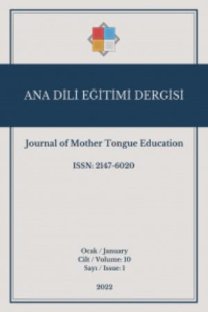Türkçeye Uyarlanmış Dinleme Stili Ölçeği’nin Değerlendirilmesi
Türkçe literatürde “dinleme türü” ile aynı anlamda kullanılan “dinleme stili”, İngilizce literatürde “listening style” adıyla dinleme türünden (listening type) farklı anlama gelecek şekilde kullanılmaktadır. Dinleme stili, “bireyin dinleme davranışlarını etkileyen baskın dinleme biçimi”ni ifade etmektedir. Yapılan farklı dinleme stili sınıflandırmalarından biri, bu araştırmanın konusunu oluşturan Pearce, Johnson ve Barker’a (2003) ait Dinleme Stili Ölçeği'nde (Listening Style Inventory; Pearce) yer almaktadır. Bu sınıflamaya göre dinleme stilleri “etkin, ilgili, edilgin ve ilgisiz dinleme”den oluşmaktadır. Bu stiller “etkin dinleme”nin uygulanma derecelerini ifade etmesine rağmen ölçeğin Türkçe uyarlamasında bu özellik dikkate alınmamıştır. Böyle olunca sonraki çalışmalarda ölçeğin hatalı biçimi kullanılmış, hatta ölçekte yer alan dinleme stilleri, dinleme türü olarak bazı kaynaklarda yer almıştır. Bu çalışmayla söz konusu hataların giderilmesi amaçlanmaktadır.
Assessment of the Adapted Version of the Listening Styles Inventory to Turkish
In the professional literature in Turkish, listening style and listening type are used in the same sense whereasin the professional literature in English, these terms refer to different meanings. Listening style means “dominant listening manner that affects an individual's listening behaviors.” One of the listening style taxonomies is embodied in the Listening Style Inventory (Pearce, Johnson and Barker, 2003) which forms the focus of this study. In this taxonomy, listening styles are categorized as “active, involved, passive and detached.” Although these styles indicate degrees of active listening, they were not taken into consideration in the adaptation of the inventory to Turkish. The erroneous version of the inventory was used in subsequent studies and listening styles included in the original inventory were even referred to as listening types in some sources. This study aims to eliminate these problems.
___
- Ateş, M. ve Ercan, A. N. (2015). Türkçe öğretmenlerinin dinleme stillerinin incelenmesi. Ondokuz Mayıs Üniversitesi Eğitim Fakültesi Dergisi, 34(2), 107-119.
- Barker, R. T., Pearce, C. G. ve Johnson, I. W. (1992) An Investigation of perceived managerial listening ability. Journal of Business and Technical Communication 6 (1992): 438-57.
- Barker, R. T., Pearce, C. G. ve Johnson, I. W. (1997). Validity and reliability of the Listening Styles Inventory: continued development and refinement. Virginia Commonwealth University School of Business Excellence Fund Report, Richmond, VA.
- Bodie, G. D., Worthington, D. L. ve Gearhart, C. C. (2013). The listening styles profile-revised (LSP-R): a scale revision and evidence for validity. Communication Quarterly, 61(1), 72-90, DOI: 10.1080/01463373.2012.720343.
- Chesebro, J. L. (1999). The relationship between listening styles and conversational sensitivity. Communication Research Reports, 16(3), 233-238, DOI: 10.1080/08824099909388722.
- Epçaçan, C. (2013). Temel bir dil becerisi olarak dinleme ve dinleme eğitimi. Adıyaman Üniversitesi Sosyal Bilimler Enstitüsü Dergisi, 6(11), 331-352.
- Gordon, T. (2004). Etkili öğretmenlik eğitimi (17. Baskı, Çev. E. Aksay). İstanbul: Sistem Yayıncılık.
- Karatay, H., Dolunay, S. K. ve Savaş, Ö. (2014). Türkçe öğretmenlerinin etkin dinleme ve dönüt durumları. Ana Dili Eğitimi Dergisi, 2(4), 85-106.
- Kaya, M. F. (2014). Dinleme türleri ölçeğinin Türk kültürüne uyarlanması, dil geçerliği ve faktör yapısının belirlenmesi. Abant İzzet Baysal Üniversitesi Sosyal Bilimler Enstitüsü Dergisi, 14(3), 323-342.
- Kayaalp, İ. (2006). İletişim ve dil (2. baskı). Ankara: Türkiye Diyanet Vakfı Yayınları.
- Kemiksiz, Ö. (2015). Türkçe öğretiminde eleştirel dinleme. Erzincan Üniversitesi Sosyal Bilimler Enstitüsü Dergisi, 9(2), 299-316.
- Langer, E. (1980). Rethinking the role of thought in social ınteraction. New Directions in Attribution Research (Ed. H. Harvey, W. Ickes and R. Kidd), 2, 35-58, Hillsdale, NJ: Lawrence Erlbaum Associates.
- Lu, J. (2005). The Listening Style Inventory (LSI) as an instrument for improving listening skill. Sino-US English Teaching, 2(5), 45-50.
- Maden, S. ve Durukan, E. (2011). Türkçe öğretmeni adaylarının dinleme stillerinin çeşitli değişkenler açısından değerlendirilmesi. Mehmet Akif Ersoy Üniversitesi Sosyal Bilimler Enstitüsü Dergisi, 3(4), 101-112.
- Pearce, C. G., Johnson, I. W. ve Barker, R. T. (2003). Assessment of the Listening Styles Inventory. Journal of Business and Technical Communication, 17(1), 84-113.
- Purdy, M. (1996). What is listening. Listening in Everyday Life (2nd Edition; Ed. M. Purdy and D. Borisoff), Maryland: University Press of America.
- Sargent, S. L., Fitch-Hauser, M. ve Weaver, J. B. (1997). A listening styles profile of the type-a personality. International Journal of Listening, 11(1), 1-14, DOI: 10.1207/s1932586xijl1101_1.
- Tabak, G. (2013). Türkçe öğretmeni adaylarının dinleme stillerinin bazı değişkenler açısından değerlendirilmesi. Mustafa Kemal Üniversitesi Sosyal Bilimler Enstitüsü Dergisi, 10(22), 171- 181.
- Tompkins, G. E. (1998). Language arts: content and teaching strategies. PO: An Imprint of Prentice Hall.
- Watson, K. W., Barker, L. L. ve Weaver, J. B. (1995). The Listening Styles Profile (LSP-16): development and validation of an instrument to assess four listening styles. International Journal of Listening, 9, 1-13.
- Weaver, J. B., Watson, K. W. ve Barker, L. L. (1996). Individual differences in listening styles: do you hear what I hear. Personality and Individual Differences, 20(3), 381-387.
- Wolvin, A. D. ve Coakley, C. G. (1992). Listening (5th Edition). Dubuque, IA: Wm. C. Brown.
- ISSN: 2147-6020
- Yayın Aralığı: Yılda 4 Sayı
- Başlangıç: 2013
- Yayıncı: Mehmet Kurudayıoğlu
Sayıdaki Diğer Makaleler
Çocuk Edebiyatı ve Duyarlık Eğitimi
Yurt Dışında Yaşayan Türk Çocuklarına Yönelik Yapılan Araştırmalar Üzerine Bir Analiz Çalışması
Seçil ORTAKÖYLÜ, Sinem SATILMIŞ, Bircan EYÜP
Türkçeye Uyarlanmış Dinleme Stili Ölçeği’nin Değerlendirilmesi
Mehmet KURUDAYIOĞLU, Ömer SAVAŞ
Öğrencilerin Hazırlıksız Konuşmalarında Kelime Hazinesi Katsayıları
Türkçe Eğitimi Açısından Ses-Harf Sıklığı Üzerine Bir Değerlendirme
Düşünen Sınıf Materyallerinin (DSM) PISA Okuma Becerileri Üzerinde Etkisi
Yazma Becerisiyle İlgili Makaleler Üzerine Bir İnceleme: Web of Science Veri Tabanında Eğilimler
